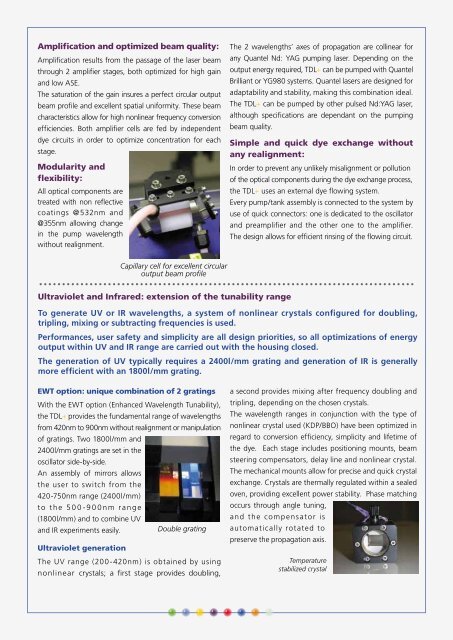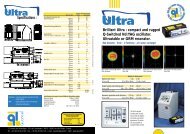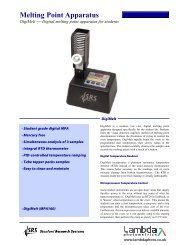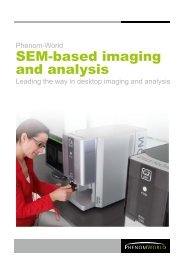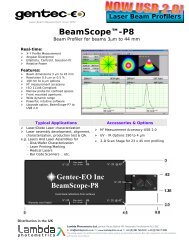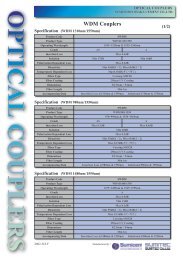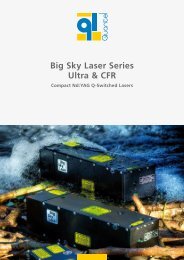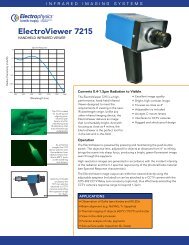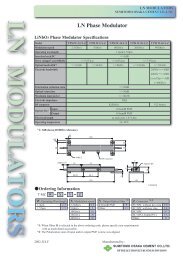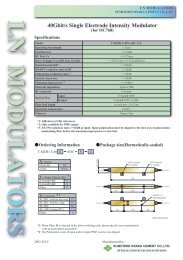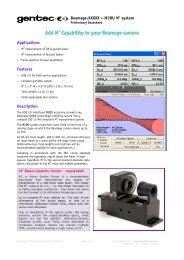User-friendly Tunable Dye Laser - Lambda Photometrics
User-friendly Tunable Dye Laser - Lambda Photometrics
User-friendly Tunable Dye Laser - Lambda Photometrics
You also want an ePaper? Increase the reach of your titles
YUMPU automatically turns print PDFs into web optimized ePapers that Google loves.
Amplification and optimized beam quality:<br />
Amplification results from the passage of the laser beam<br />
through 2 amplifier stages, both optimized for high gain<br />
and low ASE.<br />
The saturation of the gain insures a perfect circular output<br />
beam profile and excellent spatial uniformity. These beam<br />
characteristics allow for high nonlinear frequency conversion<br />
efficiencies. Both amplifier cells are fed by independent<br />
dye circuits in order to optimize concentration for each<br />
stage.<br />
Modularity and<br />
flexibility:<br />
All optical components are<br />
treated with non reflective<br />
coatings @532nm and<br />
@355nm allowing change<br />
in the pump wavelength<br />
without realignment.<br />
The 2 wavelengths’ axes of propagation are collinear for<br />
any Quantel Nd: YAG pumping laser. Depending on the<br />
output energy required, TDL+ can be pumped with Quantel<br />
Brilliant or YG980 systems. Quantel lasers are designed for<br />
adaptability and stability, making this combination ideal.<br />
The TDL+ can be pumped by other pulsed Nd:YAG laser,<br />
although specifications are dependant on the pumping<br />
beam quality.<br />
Simple and quick dye exchange without<br />
any realignment:<br />
In order to prevent any unlikely misalignment or pollution<br />
of the optical components during the dye exchange process,<br />
the TDL+ uses an external dye flowing system.<br />
Every pump/tank assembly is connected to the system by<br />
use of quick connectors: one is dedicated to the oscillator<br />
and preamplifier and the other one to the amplifier.<br />
The design allows for efficient rinsing of the flowing circuit.<br />
Capillary cell for excellent circular<br />
output beam profile<br />
Ultraviolet and Infrared: extension of the tunability range<br />
To generate UV or IR wavelengths, a system of nonlinear crystals configured for doubling,<br />
tripling, mixing or subtracting frequencies is used.<br />
Performances, user safety and simplicity are all design priorities, so all optimizations of energy<br />
output within UV and IR range are carried out with the housing closed.<br />
The generation of UV typically requires a 2400l/mm grating and generation of IR is generally<br />
more efficient with an 1800l/mm grating.<br />
EWT option: unique combination of 2 gratings<br />
With the EWT option (Enhanced Wavelength Tunability),<br />
the TDL+ provides the fundamental range of wavelengths<br />
from 420nm to 900nm without realignment or manipulation<br />
of gratings. Two 1800l/mm and<br />
2400l/mm gratings are set in the<br />
oscillator side-by-side.<br />
An assembly of mirrors allows<br />
the user to switch from the<br />
420-750nm range (2400l/mm)<br />
t o t h e 5 0 0 - 9 0 0 n m r a n g e<br />
(1800l/mm) and to combine UV<br />
and IR experiments easily. Double grating<br />
Ultraviolet generation<br />
The UV range (200-420nm) is obtained by using<br />
nonlinear crystals; a first stage provides doubling,<br />
a second provides mixing after frequency doubling and<br />
tripling, depending on the chosen crystals.<br />
The wavelength ranges in conjunction with the type of<br />
nonlinear crystal used (KDP/BBO) have been optimized in<br />
regard to conversion efficiency, simplicity and lifetime of<br />
the dye. Each stage includes positioning mounts, beam<br />
steering compensators, delay line and nonlinear crystal.<br />
The mechanical mounts allow for precise and quick crystal<br />
exchange. Crystals are thermally regulated within a sealed<br />
oven, providing excellent power stability. Phase matching<br />
occurs through angle tuning,<br />
and the compens ator is<br />
automatically rotated to<br />
preserve the propagation axis.<br />
Temperature<br />
stabilized crystal


